Zekkei × J.A.K.A.M. | Oyu Stone Circles
絶景×アーティストの縄文特集第二弾として、7月に世界文化遺産に登録が決まった「北海道・北東北の縄文遺跡群」の構成要素の一つでもある、秋田県は鹿角市の大湯環状列石にて撮影された、アーティストJ.A.K.A.M.さんによるDJプレイを公開しました!
As the second installment of our “ZEKKEI ×Artist” Jomon feature, we’ve released a DJ performance by J.A.K.A.M., shot at the Oyu Stone Circles in Kazuno City, Akita Prefecture, which is one of the components of the “the Jomon Prehistoric Sites in Nothern Japan”, which was registered as a World Heritage Site in July!
この映像の収録自体は昨年の9月に行いました。北東北の縄文遺跡で撮影をするというアイデアが出た際に、J.A.K.A.M.さんも興味を持ってくれて、しかも父方の彼のおばあちゃんが元々秋田に所縁があるということで、出演をお願いしたものです。
The shooting of this video was done in September last year. When we came up with the idea of filming at a Jomon site in the northern Tohoku region, J.A.K.A.M. was interested, and since his paternal grandmother was originally related to Akita, we asked him to appear.
大湯環状列石に関する詳しいお話は、この後、THAT IS GOODでも数々の縄文遺跡をレポートしてくれている縄文ユニット「縄と矢じり」の草刈さんの記事と同じく廣川さんの写真に譲りますが、そこから抜粋すると「環状列石とは何かということについては、墓地や祭祀の場のほかに、天体観測を行った場などの説がある。」ということです。
実際に早朝から準備を行い日の出を待って撮影をおこなったのですが、日時計の様に配置された環状列石を眼前に日の出を望むと、天体の動きや季節の移ろいを観察したものではないか…と、それだけが目的の遺跡だった訳ではないかもしれませんが、宇宙や自然の流れとリンクしているのだろうという印象をとても身近に感じることができました。
For more information on the Oyu ringstone, I’ll leave it to Ms. Kusakari of the Jomon unit “nawa to yajiri”, who has reported on many Jomon sites for THAT IS GOOD, and also to Mr. Hirokawa’s photos. Here is an excerpt from the report: “There are several theories as to what the ringstone is, including a cemetery, a ritual site, and a site for astronomical observation.”
We actually made preparations early in the morning and waited for the sunrise to shoot the video, but as we watched the sunrise in front of the stonework in the shape of a sundial, we imagined that they must have been observing the movement of astronomical objects and the change of seasons. This may not have been the only purpose of the site, but it gave me the impression that it was linked to the universe and the flow of nature.
宇宙や自然の流れとリンクしたとても「力」を感じる「場」で、「宇宙や自然の力の流れ」やそして「そこに生きる我々の営み」を表現したようなJ.A.K.A.M.さんの音に身を任せて目を瞑ると、徐々に空気を温める9月の朝の太陽が優しく肌を暖め始める感触を思い出します。
特に前半5分くらいから15分あたり、徐々に太陽が顔を出し光線を広げ、環状列石の大地を徐々に温めていく様は圧巻です。J.A.K.A.M.さんの楽曲も相まって、この世界の美しさやキラメキを心から感じさせてくれます。
It was a “place” where I could feel the “power” linked to the flow of the universe and nature, and when I let myself meditate on J.A.K.A.M.’s sound, which seemed to express the “flow of the power of the universe and nature” and “the life we live in it,” I remembered the feeling of the sun on a September morning that gradually warmed the air and began to gently warm my skin. Especially from about 5 to 15 minutes into the video, the sun gradually comes out and spreads its rays, gradually warming the earth of the Stone Circles
The music by J.A.K.A.M., combined with the beautiful view, makes you truly feel the beauty and glitter of this world..
さらに草刈さんの記事によると、この環状列石はタイトルにもある通り「死と再生のモニュメント」だったのかもしれません。締めの言葉にもあるように
「…ここで行われた祭りは、どのようなものだったのか。これまで数々の祭りの場を創り出してきた JUZU a.k.a. MOOCHY こと J.A.K.A.M.の繰り出す音楽とともに想像してみてはいかがだろうか。」
全くその通りで、映像に納めた日の出の美しさとともに、皆さんにも想像を膨らませながらお楽しみいただければと思います。
Furthermore, according to Kusakari’s article, this Stone Circles may have been a “monument to death and rebirth,” as the title suggests. As she says in her closing remarks,
“When I think about it, I think that the grave was a positive place to live in the future.
What was the nature of the festival that took place here? Let’s imagine it with the music of J.A.K.A.M. as known as JUZU a.k.a. MOOCHY, who has created many festival places in the past.”
That’s exactly what I thought, and I hope everyone can enjoy the beauty of the sunrise on film while letting their imaginations run wild.
それではここから草刈さんの記事が始まります。最後にもう一度、今回の撮影のエピソードを追加で少しご紹介します。
So here is the start of her article. One last time, I would like to introduce a few additional episodes from this shooting.
2021年7月に世界文化遺産に登録された北海道・北東北の縄文遺跡群。その構成資産のひとつである大湯環状列石は、山深い秋田県鹿角市の小高い台地上にある2つのストーンサークルの総称である。
Jomon Prehistoric Sites in Northern Japan were registered as a World Cultural Heritage site in July 2021. One of its constituent assets, the Oyu Stone Cercles, is the collective name for two stone circles located on a small plateau in the mountainous city of Kazuno, Akita Prefecture.
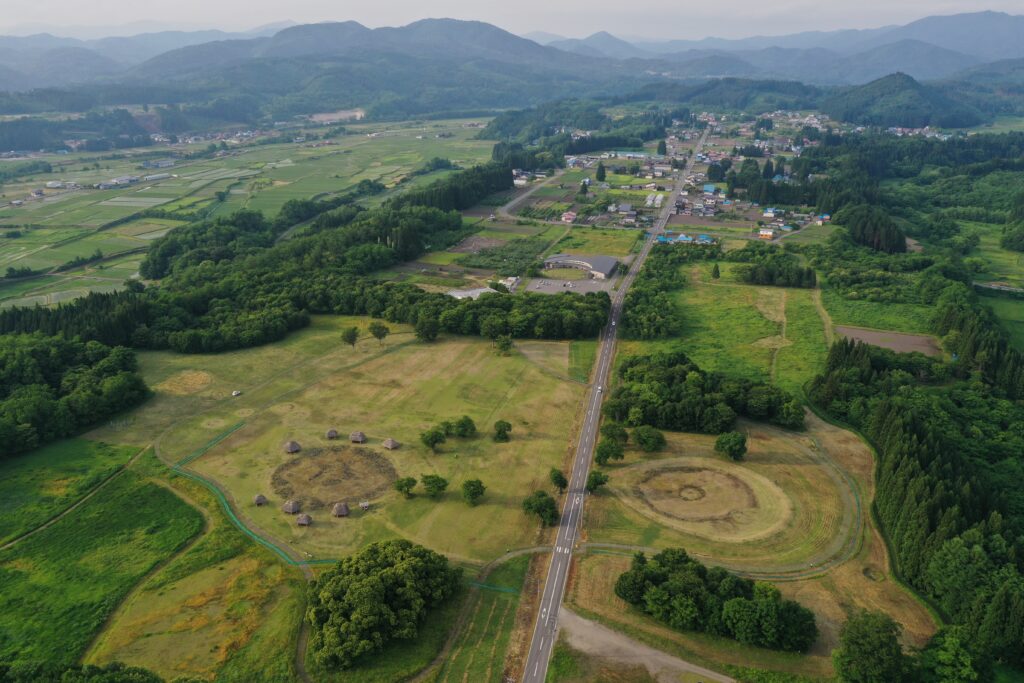
環状列石としては国内最大級の万座(最大径52m)とそれより一回り小さな野中堂(最大径44m)は、いずれも中心と外周の2重の輪を描く配列になっている。間近でみると、それらは石を数十個組み合わせた組み石で構成されているのがわかる。
石の数はおよそ7200個。その95%を占める淡い緑色の石は、遺跡から7km離れた川からおよそ200年かけて少しずつ運ばれたものだ。小さなもので10〜20kg、大きいもので200kgもある石を運び、並べたのは、4000年前〜3500年前の縄文時代後期に生きた人々である。
Manza (52m in diameter), one of the largest stone circles in Japan, and Nonakado (44m in diameter), a smaller stone circle, are both arranged in a double ring around the center and periphery. Up close, you can see that they are made up of dozens of assembled stones.
There are about 7,200 stones. The pale green stones, which occupy 95% of the total, were transported little by little from a river 7 km away from the ruins over a period of about 200 years. The people who carried and arranged the stones, some of which weighed 10 to 20 kilograms for small ones and 200 kilograms for large ones, were people who lived in the late Jomon period between 4,000 and 3,500 years ago.
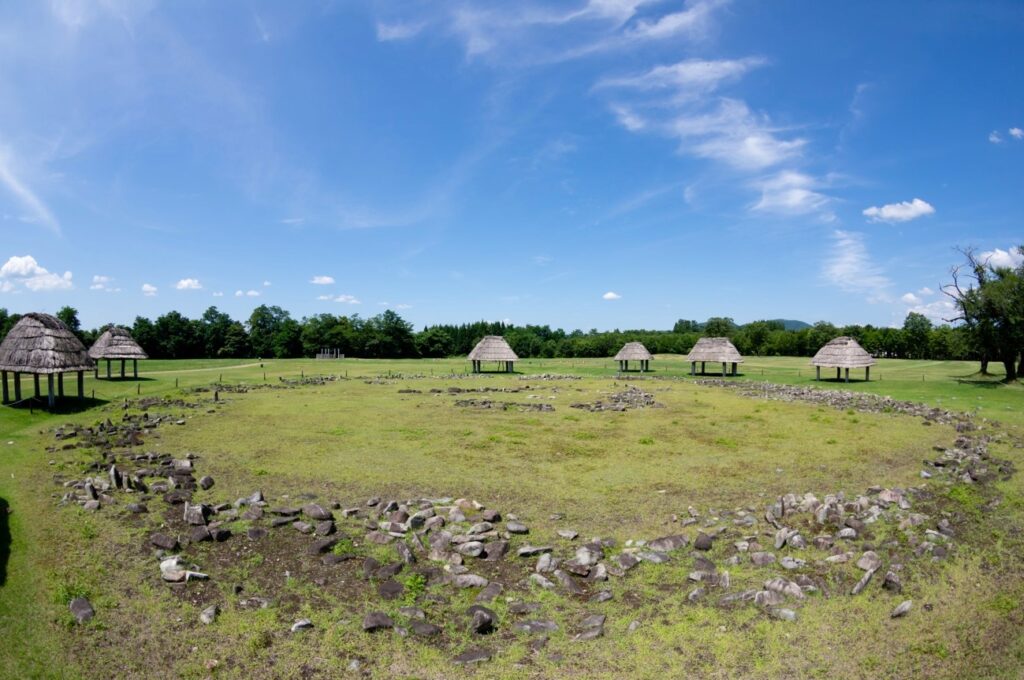

環状列石とは何かということについては、墓地や祭祀の場のほかに、天体観測を行った場などの説がある。そのどれもが大湯環状列石に当てはまるといっていいだろう。
2つのストーンサークルの中心とそれぞれに付随する日時計状組石という立石を一直線に結んだ線上に夏至の太陽が沈むのはよく知られた話だ。そもそも遮るものの少ない台地上にあるため、周辺の山並みもよくみえて、天体観測をするには適した場所なのである。
さらに、遺跡から儀式に使われる装飾的な器や鈴のようなものが多く出土しているので、祭祀の場としての説も否定できない。
そして、墓地であるということについても、大湯環状列石では人骨こそ出ていないが、過去の調査で組み石10数基の下から、人為的に掘られた土坑墓と思しき穴が見つかっているので、おそらくは墓なのである。
Regarding what a stone circle is, there are theories that it is a cemetery, a place of ritual, or a place where astronomical observations were made. All of these theories can be applied to the Oyu Stone Circles.
It is well known that the summer solstice sun sets on a straight line connecting the center of the two stone circles with their associated stonework in the shape of a sundial. Since the site is located on an open plateau, the surrounding mountains can be seen clearly, making it an ideal place for astronomical observation.
Furthermore, many decorative vessels and bell-like objects used in rituals have been excavated from the site, so the theory that it was a place for rituals cannot be denied.
As for the cemetery, although no human remains were found at the Oyu Stone Circles, past surveys have found holes that appear to have been artificially dug beneath more than ten masonry stones, so it is probably a grave.
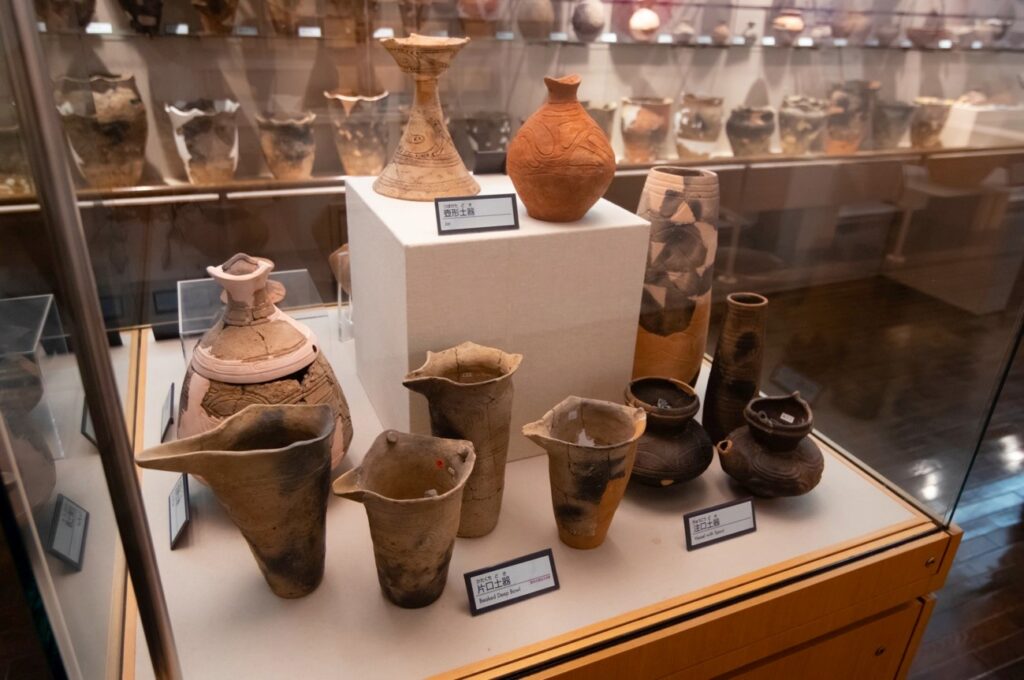
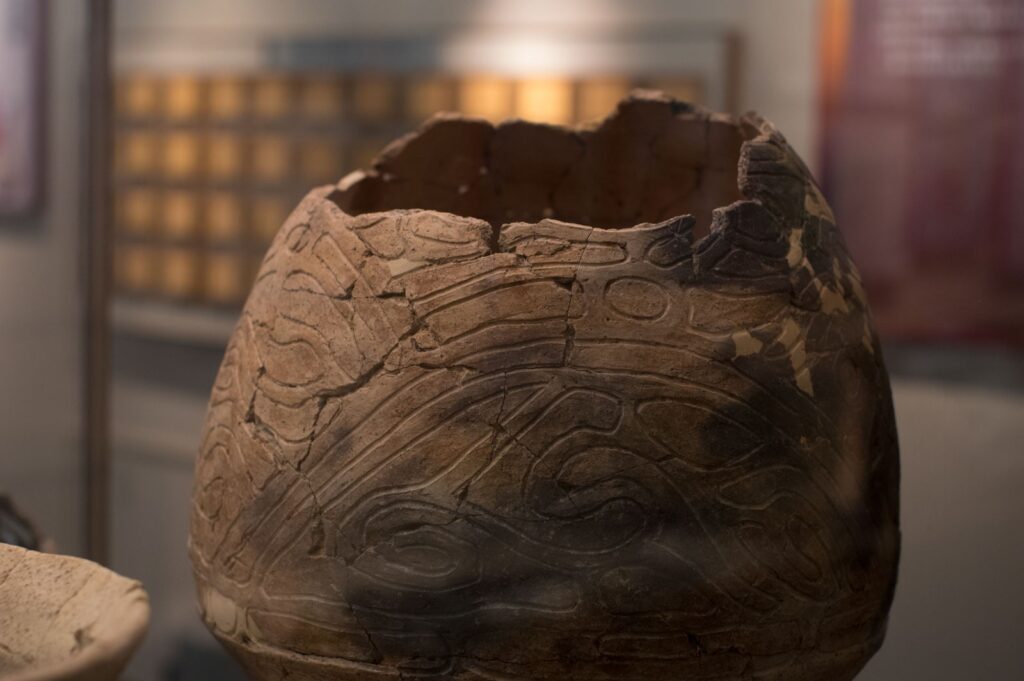
近年、北海道・北東北の環状列石では、この墓としての説に再送墓の可能性が指摘されるようになった。再送とは遺体を一次的に安置して白骨化させてから二次葬を行う風習で、日本の古い葬送儀礼の形とされている。
それが大湯環状列石でも行われていたということを具体的に示すのは、それぞれの環状列石を囲むように4本や6本単位で見つかった柱の跡である。現在それらは、環状列石の外周に掘立柱建物として復元されているが、環状列石が営まれていた頃には、遺体を安置する死者のための場所になっていたのかもしれない。
In recent years, the possibility of a re-transfer grave has been pointed out in this theory of graves in the Stone Circles of Hokkaido and North Tohoku. Re-transportation is a custom in which a body is placed in a primary burial site and allowed to whiten before a secondary burial, and is considered to be an old form of funeral ritual in Japan.
The fact that this was also done at the Oyu Stone Circles is concretely shown by the remains of four or six pillars found surrounding each circles. These pillars have now been reconstructed as dugout pillar buildings around the periphery of the stone circles, but they may have been used as places for the dead to lay their bodies to rest when the stone circles were in operation.

遺体を白骨化させると聞くと、非常におどろおどろしい儀式を想像してしまうが、沖縄や奄美地方でみられる洗骨風習のように、2度も死者を弔うというのは非常にていねいな埋葬の仕方である。
葬儀がシステマチックに行われる現代では、死を受け入れる時間のないまま遺体は火葬されてしまうが、再送であれば残された人々にとっても死を受け止めるための時間がたっぷりあったはずだ。また、死んだら肉体が朽ちていくという当たり前のことを自然と理解できたのだと思う。
When you hear about the process of turning a body into white bones, you may imagine a very frightening ritual, but mourning the dead twice, as is the custom of washing bones in Okinawa and Amami regions, is a very careful way of burial.
In today’s world where funerals are systematic, bodies are cremated without any time to accept death, but in the case of re-transfer, the people left behind would have had plenty of time to accept death. Also, I think that the people could naturally understand the obvious fact that the body decays after death.

結論からいうと、環状列石は限りなく死者に近い場所なのかもしれない。残された人々はここで祖先とつながり、自分がどういう血筋なのかを知ることができたはずだ。戸籍のないこの時代に自分は何者であるかを知るのも、墓の役割だろう。そう考えると、墓というのは未来を生きるためのポジティブな場だったのではないかとも思う。
ここで行われた祭りは、どのようなものだったのか。これまで数々の祭りの場を創り出してきたJUZU a.k.a. MOOCHYことJ.A.K.A.Mの繰り出す音楽とともに想像してみてはいかがだろうか。
In conclusion, the Stone Circles may be a place that is as close to the dead as possible. It is here that the remaining people would have been able to connect with their ancestors and find out who they are. In this age when there is no family register, the role of the grave is to know who you are. When I think about it, I think that the grave was a positive place to live in the future.
What was the nature of the festival that took place here? Let’s imagine it with the music of J.A.K.A.M. as known as JUZU a.k.a. MOOCHY, who has created many festival places in the past.
文:草刈朋子(縄と矢じり) 写真:廣川慶明(縄と矢じり)
Text : Tomoko Kusakari (nawa to yajiri), Photos : Yoshiaki Hirokawa (nawa to yajiri)
参考文献:『環状列石ってなんだ』(御所野縄文博物館編/新泉社刊)
Reference : 「Kanjo Resseki tte nanda (What is Stone Circles?)」(Goshono Jomon Site Edit / Published by Shinsensha)
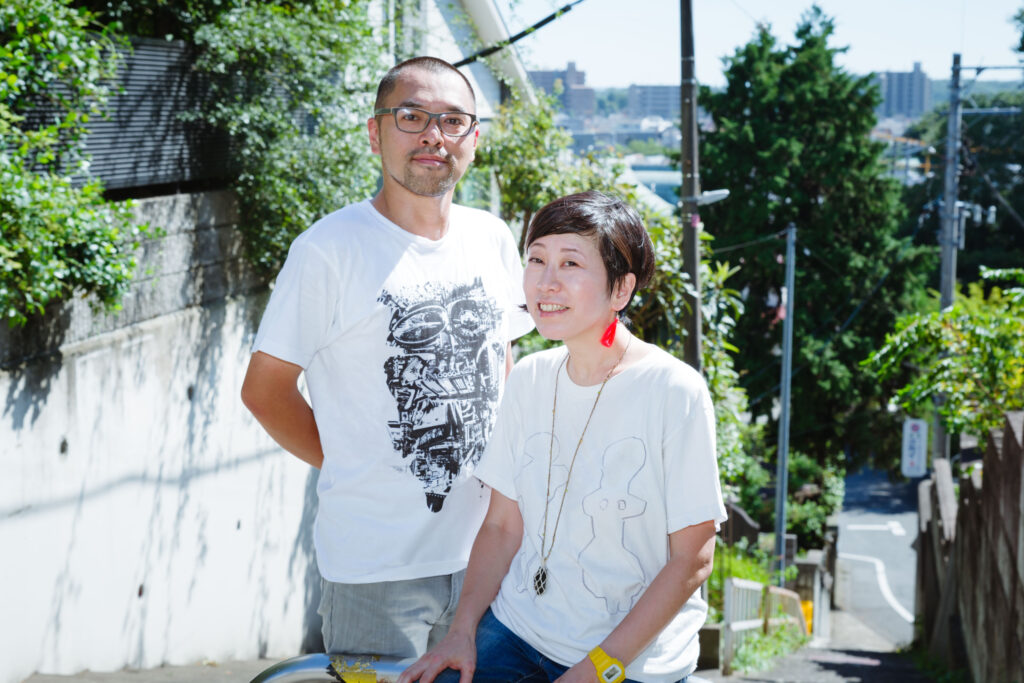
縄と矢じり
nawa to yajiri
(it means “Rope and Arrowhead”)
文章担当の草刈朋子と写真担当の廣川慶明による縄文探求ユニット。ともにNPO法人jomonismのメンバーとして活動するほか、全国の縄文遺跡と考古館や郷土館をめぐる縄文旅をしながら各地の縄文のカタチ、環境から読み解ける先史時代の価値観を探求中。
http://nawatoyajiri.com
A unit for exploring the Jomon by Tomoko Kusakari (writing) and Yoshiaki Hirokawa (photography).
In addition to working as members of the NPO Jomonism, they also travel around Japan visiting Jomon ruins, archaeological sites and local museums, exploring the prehistoric values that can be deciphered from the forms and environments of the Jomon.
http://nawatoyajiri.com
ところで、毎回様々な出会いやご縁に導かれて何とか撮影を成功させているTHAT IS GOODの絶景シリーズですが、今回も思ってもみない出会いがありました。
By the way, each time we’re guided by various encounters and fates, we manage to succeed in taking pictures for the THAT IS GOOD series of ZEKKEI, and this time we had another unexpected encounter.
太古縄文の聖地、美しい風景、宇宙や自然の移ろい、連綿と続く私たちの営みを映像と音楽を通して感じていただければ幸いです!
We hope that through the videos and music, you will be able to feel the sacred sites of ancient Jomon, the beautiful scenery, the changes in the universe and nature, and our continuous work.
文:THAT IS GOOD編集部 中村
TEXT : THAT IS GOOD editorial department, Nakamura